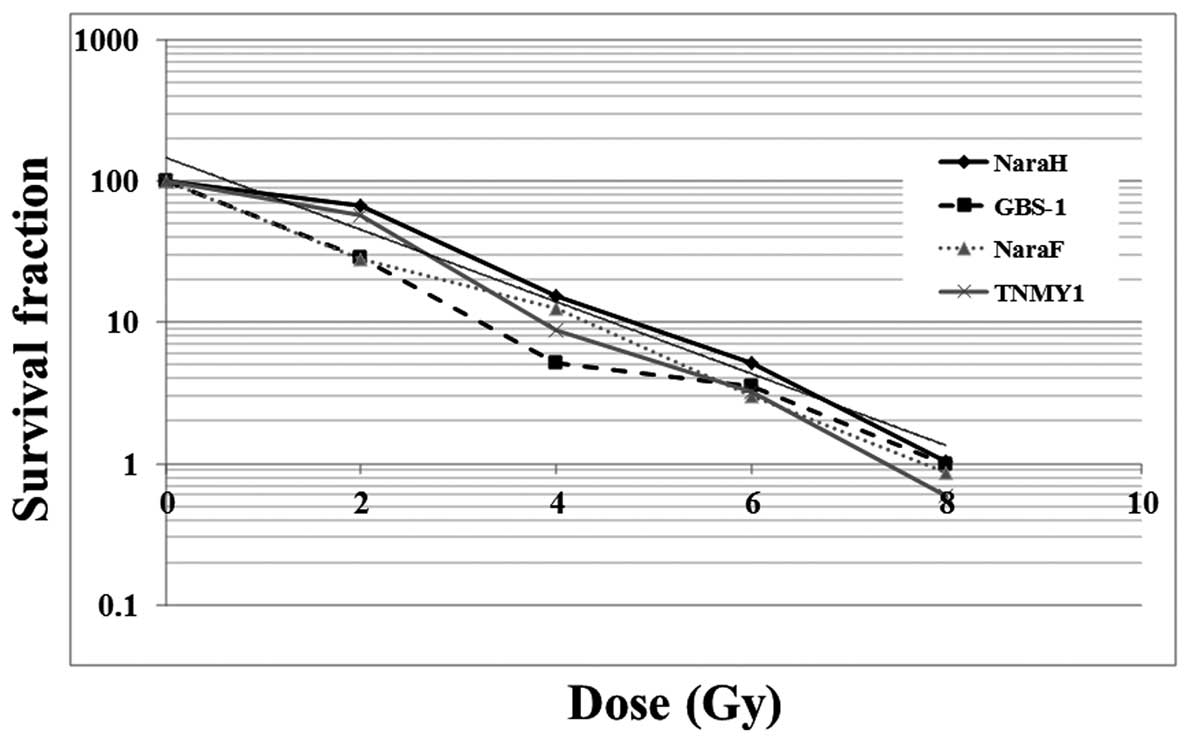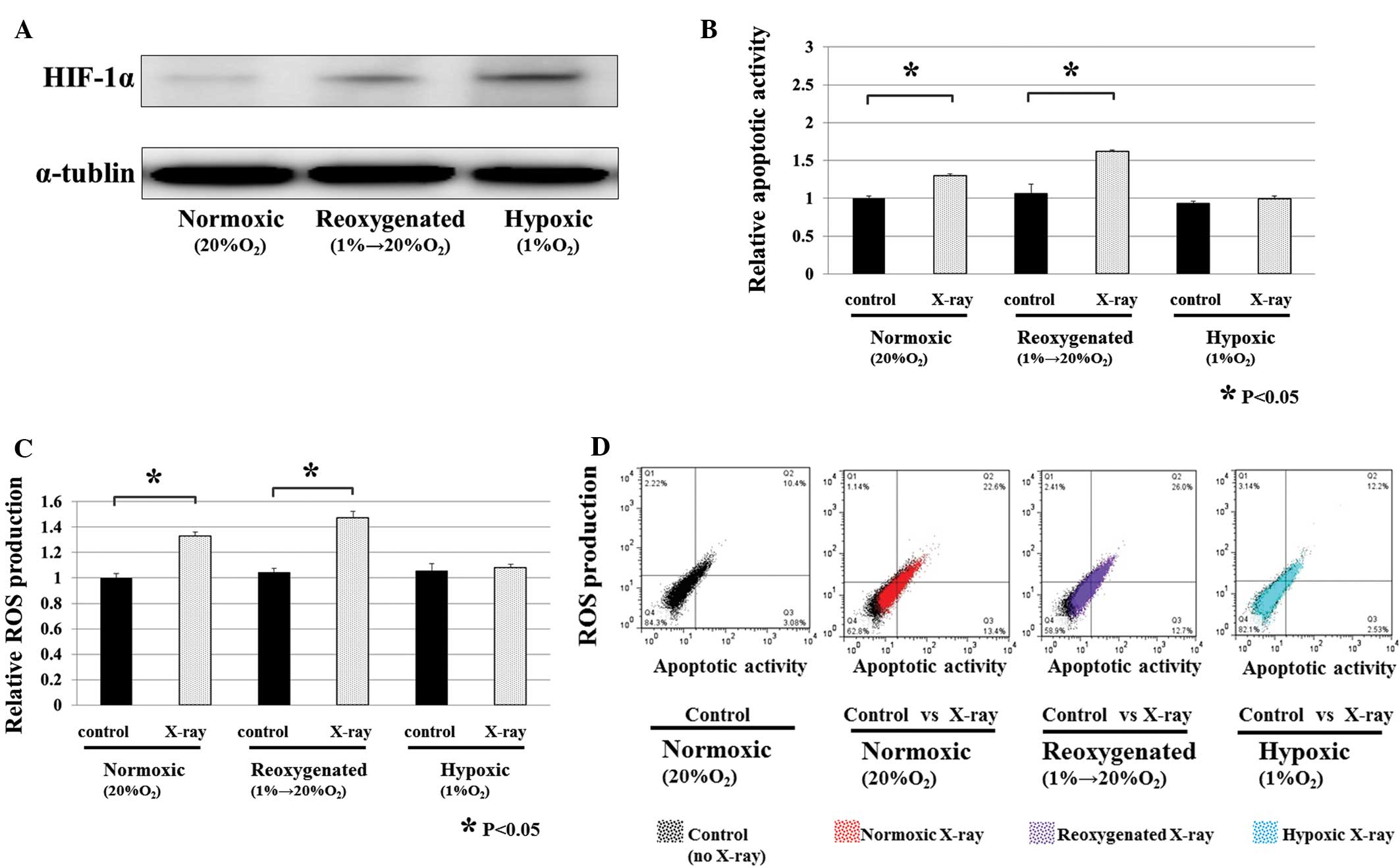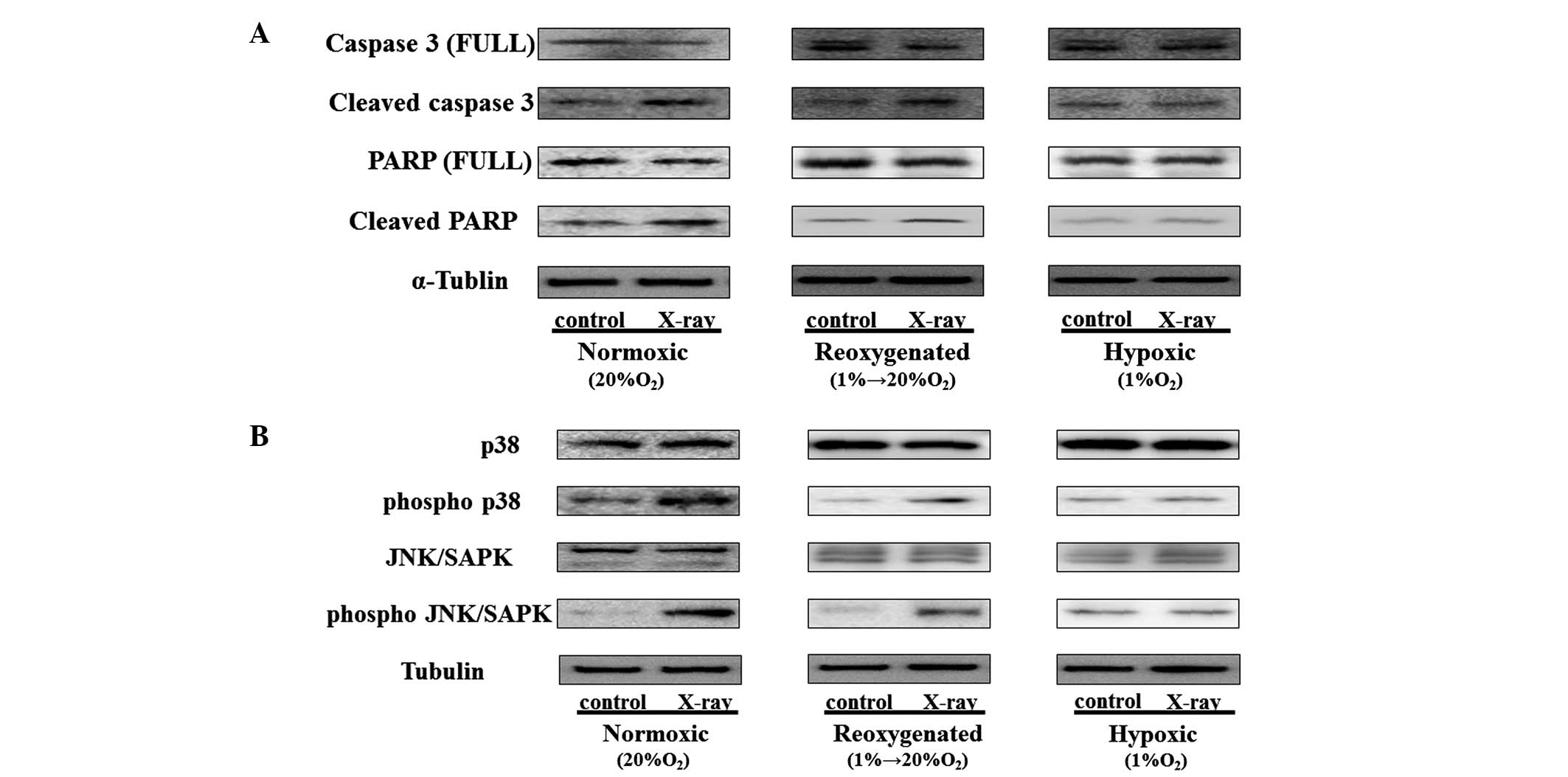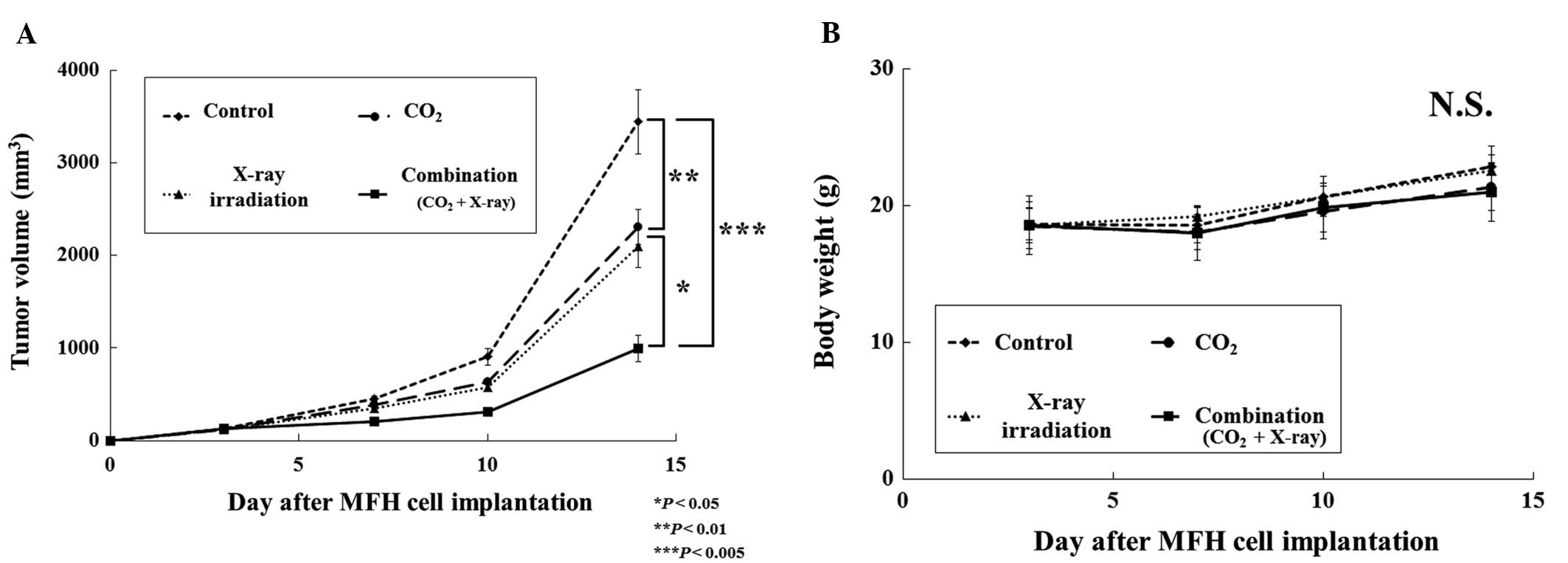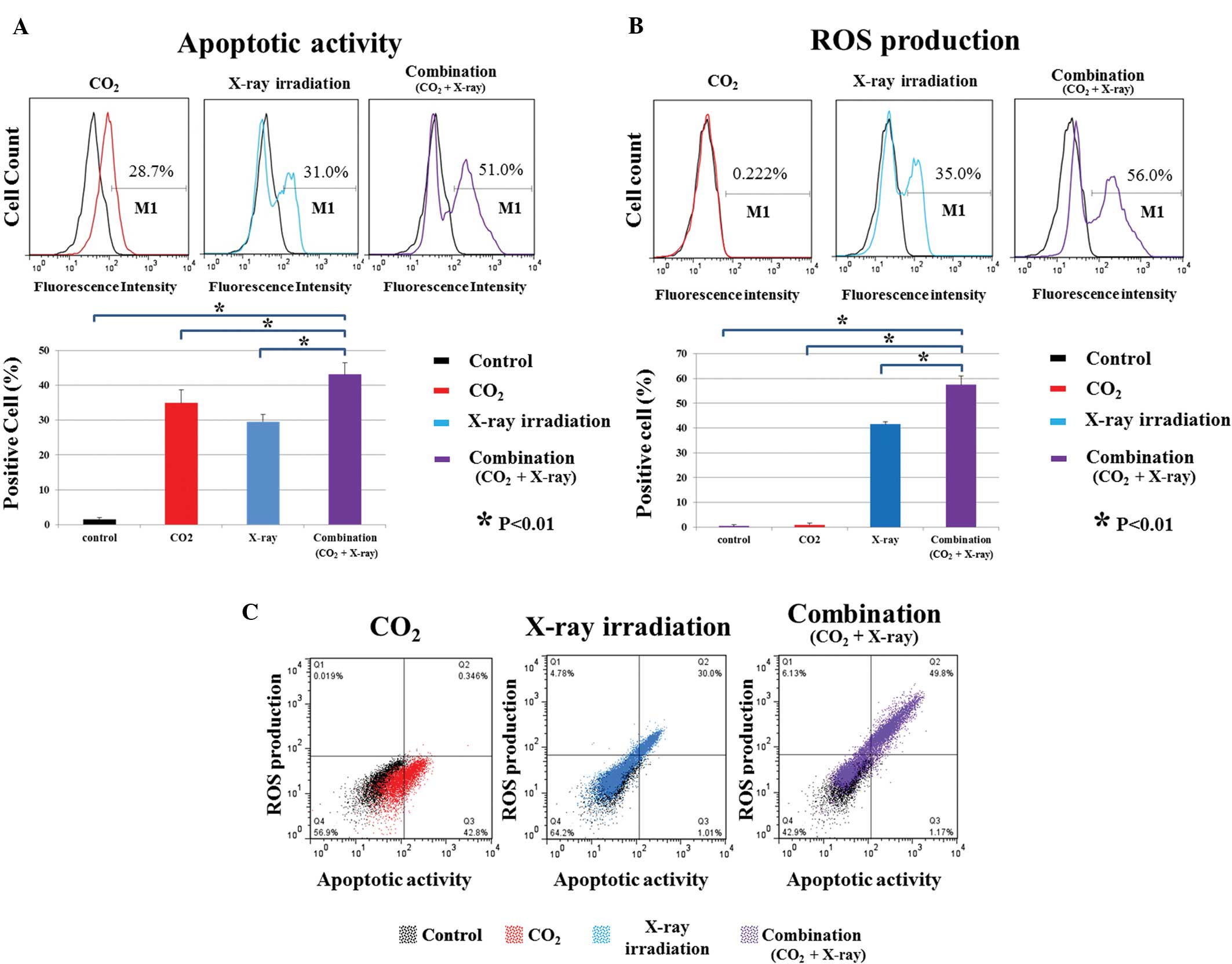|
1
|
Le DV, Coindre JM, Leroux A, et al:
Prognostic factors for patients with localized primary malignant
fibrous histiocytoma: a multicenter study of 216 patients with
multivariate analysis. Cancer. 77:1823–1830. 1996. View Article : Google Scholar : PubMed/NCBI
|
|
2
|
Ruan K, Song G and Ouyang G: Role of
hypoxia in the hallmarks of human cancer. J Cell Biochem.
107:1053–1062. 2009. View Article : Google Scholar : PubMed/NCBI
|
|
3
|
Gray LH, Conger AD, Ebert M, Hornsey S and
Scott OC: The concentration of oxygen dissolved in tissues at the
time of irradiation as a factor in radiotherapy. Br J Radiol.
26:638–648. 1953. View Article : Google Scholar : PubMed/NCBI
|
|
4
|
Moeller BJ, Richardson RA and Dewhirst MW:
Hypoxia and radiotherapy: opportunities for improved outcomes in
cancer treatment. Cancer Metastasis Rev. 26:241–248. 2007.
View Article : Google Scholar : PubMed/NCBI
|
|
5
|
Bennett M, Feldmeier J, Smee R and Milross
C: Hyperbaric oxygenation for tumour sensitisation to radiotherapy.
Cochrane Database Syst Rev. 19:CD0050072005.
|
|
6
|
Henke M, Laszig R, Rube C, et al:
Erythropoietin to treat head and neck cancer patients with anaemia
undergoing radiotherapy: randomised, double-blind,
placebo-controlled trial. Lancet. 362:1255–1260. 2003. View Article : Google Scholar
|
|
7
|
Resch KL and Just U: Possibilities and
limits of CO2balneotherapy. Wien Med Wochenschr.
144:45–50. 1994.(In German).
|
|
8
|
Hartmann BR, Bassenge E and Pittler M:
Effect of carbon dioxide-enriched water and fresh water on the
cutaneous microcirculation and oxygen tension in the skin of the
foot. Angiology. 48:337–343. 1997. View Article : Google Scholar : PubMed/NCBI
|
|
9
|
Riggs A: The nature and significance of
the Bohr effect in mammalian hemoglobins. J Gen Physiol.
43:737–752. 1960. View Article : Google Scholar : PubMed/NCBI
|
|
10
|
Sakai Y, Miwa M, Oe K, et al: A novel
system for transcutaneous application of carbon dioxide causing an
‘artificial Bohr effect’ in the human body. PloS One.
6:e241372011.PubMed/NCBI
|
|
11
|
Onishi Y, Kawamoto T, Ueha T, et al:
Transcutaneous application of carbon dioxide (CO2)
enhances chemosensitivity by reducing hypoxic conditions in human
malignant fibrous histiocytoma. J Cancer Sci Ther. 4:174–181.
2012.
|
|
12
|
Onishi Y, Kawamoto T, Ueha T, et al:
Transcutaneous application of carbon dioxide (CO2)
induces mitochondrial apoptosis in human malignant fibrous
histiocytoma in vivo. PloS One. 7:e491892012.PubMed/NCBI
|
|
13
|
Harada R, Kawamoto T, Ueha T, et al:
Reoxygenation using a novel CO2 therapy decreases the
metastatic potential of osteosarcoma cells. Exp Cell Res.
319:1988–1997. 2013.PubMed/NCBI
|
|
14
|
Tominaga H, Kodama S, Matsuda N, Suzuki K
and Watanabe M: Involvement of reactive oxygen species (ROS) in the
induction of genetic instability by radiation. J Radiat Res.
45:181–188. 2004. View Article : Google Scholar : PubMed/NCBI
|
|
15
|
Engel RH and Evens AM: Oxidative stress
and apoptosis: a new treatment paradigm in cancer. Front Biosci.
11:300–312. 2006. View
Article : Google Scholar : PubMed/NCBI
|
|
16
|
Kyriakis JM and Avruch J: Mammalian
mitogen-activated protein kinase signal transduction pathways
activated by stress and inflammation. Physiol Rev. 81:807–869.
2001.PubMed/NCBI
|
|
17
|
Samuni AM, Kasid U, Chuang EY, et al:
Effects of hypoxia on radiation-responsive stress-activated protein
kinase, p53, and caspase 3 signals in TK6 human lymphoblastoid
cells. Cancer Res. 65:579–586. 2005.PubMed/NCBI
|
|
18
|
Mishra KP: Cell membrane oxidative damage
induced by gamma-radiation and apoptotic sensitivity. J Environ
Pathol Toxicol Oncol. 23:61–66. 2004. View Article : Google Scholar : PubMed/NCBI
|
|
19
|
Kiyozuka Y, Nakagawa H, Uemura Y, et al:
Novel cell lines established from a human myxoid malignant fibrous
histiocytoma arising in the uterus. Cancer Genet Cytogenet.
127:7–15. 2001. View Article : Google Scholar : PubMed/NCBI
|
|
20
|
Nakatani T, Marui T, Yamamoto T, et al:
Establishment and characterization of cell line TNMY1 derived from
human malignant fibrous histiocytoma. Pathol Int. 51:595–602. 2001.
View Article : Google Scholar : PubMed/NCBI
|
|
21
|
Fang Z, Mukai H, Nomura K, et al:
Establishment and characterization of a cell line from a malignant
fibrous histiocytoma of bone developing in a patient with multiple
fibrous dysplasia. J Cancer Res Clin Oncol. 128:45–49. 2002.
View Article : Google Scholar : PubMed/NCBI
|
|
22
|
Sasaki H, Takayama K, Matsushita T, et al:
Autophagy modulates osteoarthritis-related gene expressions in
human chondrocytes. Arthritis Rheum. 64:1920–1928. 2011. View Article : Google Scholar : PubMed/NCBI
|
|
23
|
Indovina P, Rainaldi G and Santini MT:
Hypoxia increases adhesion and spreading of MG-63 three-dimensional
tumor spheroids. Anticancer Res. 28:1013–1022. 2008.PubMed/NCBI
|
|
24
|
Moulder JE and Rockwell S: Hypoxic
fractions of solid tumors: experimental techniques, methods of
analysis, and a survey of existing data. Int J Radiat Oncol Biol
Phys. 10:695–712. 1984. View Article : Google Scholar : PubMed/NCBI
|
|
25
|
Overgaard J: Sensitization of hypoxic
tumour cells - clinical experience. Int J Radiat Biol. 56:801–811.
1989. View Article : Google Scholar : PubMed/NCBI
|
|
26
|
Budach W, Budach V, Dinges S, Stuschke M
and Sack H: Correlation between primary chemo- and radiation
sensitivity in a panel of highly malignant human soft tissue
sarcoma xenografts. Radiother Oncol. 42:181–187. 1997. View Article : Google Scholar
|
|
27
|
Deschner EE and Gray LH: Influence of
oxygen tension on x-ray-induced chromosomal damage in Ehrlich
ascites tumor cells irradiated in vitro and in vivo. Radiat Res.
11:115–146. 1959. View Article : Google Scholar : PubMed/NCBI
|
|
28
|
Henk JM and Smith CW: Radiotherapy and
hyperbaric oxygen in head and neck cancer. Interim report of second
clinical trial. Lancet. 2:104–105. 1977. View Article : Google Scholar : PubMed/NCBI
|
|
29
|
Evans JC and Bergsjo P: The influence of
anemia on the results of radiotherapy in carcinoma of the cervix.
Radiology. 84:709–717. 1965. View Article : Google Scholar : PubMed/NCBI
|
|
30
|
Rojas A: Radiosensitization with
normobaric oxygen and carbogen. Radiother Oncol. 20(Suppl 1):
65–70. 1991. View Article : Google Scholar
|
|
31
|
Rojas A, Joiner MC, Hodgkiss RJ, et al:
Enhancement of tumor radiosensitivity and reduced hypoxia-dependent
binding of a 2-nitroimidazole with normobaric oxygen and carbogen:
a therapeutic comparison with skin and kidneys. Int J Radiat Oncol
Biol Phys. 23:361–366. 1992. View Article : Google Scholar : PubMed/NCBI
|
|
32
|
Battino M, Ferri E, Gattavecchia E, et al:
Mitochondrial respiratory chain features after gamma-irradiation.
Free Radic Res. 26:431–438. 1997. View Article : Google Scholar : PubMed/NCBI
|
|
33
|
Wallace SS: Enzymatic processing of
radiation-induced free radical damage in DNA. Radiat Res. 150(Suppl
5): S60–S79. 1998. View Article : Google Scholar : PubMed/NCBI
|
|
34
|
Tobiume K, Matsuzawa A, Takahashi T, et
al: ASK1 is required for sustained activations of JNK/p38 MAP
kinases and apoptosis. EMBO Rep. 2:222–228. 2001. View Article : Google Scholar : PubMed/NCBI
|
|
35
|
Kim YS, Jhon DY and Lee KY: Involvement of
ROS and JNK1 in selenite-induced apoptosis in Chang liver cells.
Exp Mol Med. 36:157–164. 2004. View Article : Google Scholar : PubMed/NCBI
|
|
36
|
Shimizu T, Kato T Jr, Tachibana A and
Sasaki MS: Coordinated regulation of radioadaptive response by
protein kinase C and p38 mitogen-activated protein kinase. Exp Cell
Res. 251:424–432. 1999. View Article : Google Scholar : PubMed/NCBI
|
|
37
|
Kharbanda S, Saleem A, Shafman T, et al:
Ionizing radiation stimulates a Grb2-mediated association of the
stress-activated protein kinase with phosphatidylinositol 3-kinase.
J Biol Chem. 270:18871–18874. 1995. View Article : Google Scholar : PubMed/NCBI
|
|
38
|
Verheij M, Bose R, Lin XH, et al:
Requirement for ceramide-initiated SAPK/JNK signalling in
stress-induced apoptosis. Nature. 380:75–79. 1996. View Article : Google Scholar : PubMed/NCBI
|



